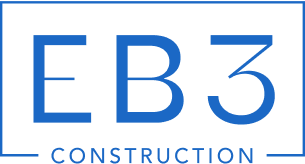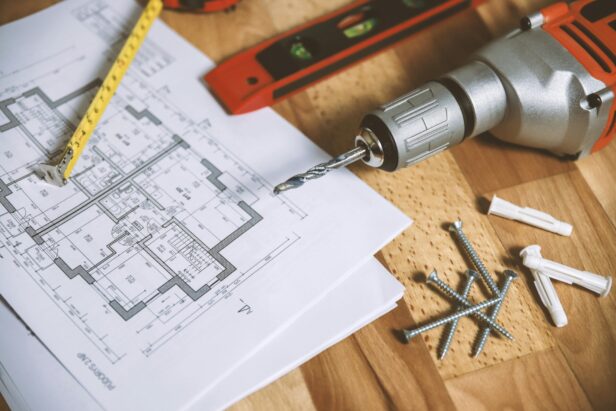Walk into any aging office building, retail center, or restaurant with outdated fixtures and faded decor, and you”ll immediately sense the need for renovation. Commercial renovations transform these tired spaces into vibrant, functional environments that better serve businesses and their customers. At EB3 Construction, we can execute these transformations by updating, expanding, or reimagining existing commercial structures to align with our clients” strategic objectives.
Commercial renovations encompass a wide range of projects, from refreshing interior finishes to complete structural overhauls. We can transform offices, retail stores, restaurants, medical facilities, and warehouses through careful planning and precise execution. The scope typically includes modernizing outdated systems, reconfiguring layouts for improved workflow, upgrading exterior facades, and ensuring compliance with current building codes and accessibility standards.
The importance of these renovations extends far beyond aesthetics. Well-executed commercial renovations can help improve the potential for returns on investment. Modernized commercial spaces are often better positioned in competitive markets. Commercial renovations can create environments that attract quality tenants, improve operational efficiency, reduce energy consumption, and potentially enhance property appeal. For developers and property owners facing aging assets or changing market demands, commercial renovations may represent a strategic opportunity to adapt and improve their properties.
What Types of Commercial Renovation Projects Are Most Common?

At EB3 Construction, we can manage a variety of commercial renovation projects, each tailored to meet specific business requirements and industry demands. Understanding common types of renovations may help property owners and developers select an approach for their needs. Let”s explore primary categories of commercial renovations that are typically executed in the industry.
Office Renovations
Office renovations are a frequent project type. These transformations can go beyond cosmetic updates to improve functionality and workplace experience. Office space renovations may focus on:
- Reconfiguring layouts to optimize space utilization and flow
- Installing new workstations that accommodate modern technology needs
- Creating collaborative areas with flexible furniture arrangements
- Upgrading technology infrastructure, including networking and AV systems
- Refreshing common areas like lobbies, break rooms, and conference spaces
Well-executed office renovations can deliver benefits, including improved employee morale, increased productivity, and stronger brand identity. There may be growing demand for renovations supporting hybrid work models with enhanced video conferencing capabilities and more adaptable workspaces.
Healthcare Facility Updates
Healthcare renovations can present unique challenges requiring specialized expertise. Medical offices, clinics, and hospitals may need regular updates to keep pace with evolving technologies while prioritizing patient comfort and privacy. Healthcare renovation projects typically include:
- Remodeling patient rooms and waiting areas for improved comfort
- Upgrading medical equipment facilities with proper infrastructure support
- Enhancing indoor air quality systems for infection control
- Installing specialized plumbing and electrical systems
- Creating more efficient workflow patterns for medical staff
The complexity of healthcare renovations often involves working within regulatory requirements while maintaining operational continuity. Close coordination with facility managers can help minimize disruptions to patient care during construction phases.
Retail Store Upgrades
Retail renovations typically focus on creating compelling customer experiences that drive sales and reinforce brand identity. These projects may involve transformation of both interior and exterior elements, including:
- Redesigning store layouts to optimize customer flow and product visibility
- Installing upgraded lighting systems to highlight merchandise
- Creating new display fixtures and point-of-sale areas
- Refreshing flooring, wall coverings, and ceiling treatments
- Modernizing storefront facades and signage
Successful retail renovations can balance aesthetic appeal with practical considerations like inventory management and loss prevention. Phased implementation plans may help minimize business disruption during the renovation process.
Hospitality Refurbishments
Hotels, restaurants, and other hospitality venues may require periodic renovations to meet changing guest expectations and maintain competitive positioning. These renovations typically include:
- Updating guest rooms with contemporary furnishings and amenities
- Revitalizing lobbies and public spaces to create memorable first impressions
- Renovating food and beverage venues with current design trends
- Enhancing recreational facilities such as pools, fitness centers, and spas
- Upgrading conference and meeting spaces with modern technology
Hospitality renovations often operate under tight timelines to minimize revenue impact. A construction management approach emphasizing careful scheduling and resource allocation can help complete work efficiently while maintaining quality standards.
Life Sciences Facility Conversions
Life sciences renovations can represent technically complex project types. These specialized facilities aim to combine form and function to support innovation while meeting regulatory requirements. Life sciences renovation work may include:
- Converting general office space to laboratory environments
- Installing specialized HVAC systems for proper air exchange and filtration
- Implementing robust electrical systems with backup power capabilities
- Creating adaptable research spaces that support collaboration
- Building specialized storage areas for materials and equipment
The demand for life sciences facilities has led to a trend of converting traditional office buildings into research spaces. Experienced contractors can guide clients through this complex conversion process, helping to support that renovated facilities meet both current operational needs and future expansion requirements.
Each commercial renovation project presents unique challenges and opportunities. By understanding these common project types, property owners and developers can better plan for the specific requirements of their renovation needs. Working with an experienced general contractor can help ensure that your commercial renovation is executed efficiently, within budget constraints, and with minimal disruption to ongoing operations.
What Are the Key Benefits of Commercial Building Renovation?
Commercial building renovations can be strategic investments that provide returns beyond aesthetic improvements. Renovation projects typically aim to create spaces that function better, cost less to operate, and potentially command higher market values.
Space Maximization and Functional Improvements
One potential benefit of commercial renovations is optimized space utilization. Renovations can transform inefficient layouts into open, purposeful environments that better serve modern business needs. By reconfiguring walls, removing outdated features, and implementing smarter storage solutions, usable square footage may increase without expanding the building footprint.
Office renovations can convert closed-off areas into collaborative workspaces with flexible partition systems. This may improve workflow for tenants and create more attractive, versatile spaces that property owners can market to future occupants.
Functional improvements can extend beyond space reorganization. Renovations may integrate technology infrastructure, improve accessibility, and enhance core building systems to ensure spaces look and function better for tenants.
Energy Efficiency and Cost Reduction
Energy efficiency is often a financially rewarding aspect of commercial renovations. Modern building systems and materials can significantly reduce operational costs. Upgrades to HVAC systems, insulation, windows, and lighting may lead to decreased utility bills.
The financial impact can be substantial. Implementing comprehensive energy efficiency upgrades may lead to significant annual savings for commercial properties. These improvements may qualify for tax incentives, utility rebates, and other financial benefits that support a strong return on investment. Buildings with high energy performance ratings may also attract tenants willing to pay premium rates for spaces aligning with corporate sustainability goals.
Beyond potential cost savings, energy-efficient buildings can provide improved comfort for occupants. Better temperature control, improved air quality, and more natural lighting may contribute to increased productivity and satisfaction among building users.
| Renovation System | Typical Cost Range (per sq.ft.) | ROI Benefits |
|---|---|---|
| Lighting | $2-$12 | Energy efficiency, reduced operating costs |
| HVAC Systems | $12-$35 | Energy savings, improved tenant comfort |
| Windows & Insulation | $45-$110 | Energy savings, improved thermal comfort |
| Modern Design & Layout | $90-$220 | Enhanced aesthetic appeal, increased property value |
| Building Code Compliance | $0.50-$5 (Permit fees) | Avoid fines, increased marketability |
Disclaimer: Pricing figures are based on publicly available market data and are intended for general estimation purposes as of undefined. They do not represent a formal quote from EB3 Construction. Actual costs will vary by project scope, location, labor rates, and material prices.
Property Value Enhancement
A potential benefit for property owners is the impact renovations may have on commercial real estate value. Renovations that modernize and improve building functionality can offer returns on investment. This value enhancement can be particularly important when preparing for a property sale or refinancing.
Strategic renovations may signal to potential buyers and tenants that a building is well-maintained and forward-thinking. In competitive real estate markets, modernized properties may command rental premiums compared to outdated counterparts. They may also experience shorter vacancy periods, potentially reducing income gaps that affect investment returns.
Building renovations often prioritize improvements that can directly influence property valuation metrics. Updated facades, modern lobbies, and efficient building systems create strong first impressions while demonstrating responsible stewardship of the property.
Tenant Attraction and Retention
Commercial renovations can impact a property”s ability to attract and retain quality tenants. In today’s market, businesses often seek spaces that reflect their brand identity and support operational needs. Renovated properties with modern amenities may outperform older spaces in tenant acquisition.
When renovations include improved natural lighting, updated common areas, and modern technology infrastructure, property owners may see reduced vacancy rates and stronger tenant interest. These improvements can allow owners to position their properties at the higher end of the market spectrum while potentially reducing concessions needed to secure leases.
Existing tenants may also respond positively to thoughtful renovations. Property improvements can coincide with lease renewals and reduced tenant turnover. This stability may provide property owners with more predictable cash flow and lower marketing costs associated with filling vacant spaces.
Reduced Maintenance Costs and Improved Compliance
Aging buildings often require increasing maintenance expenditures as systems reach the end of their useful life. Renovations that replace outdated components with modern, efficient alternatives can reduce both scheduled maintenance costs and emergency repair expenses.
Renovations typically involve an assessment of building systems presenting the highest maintenance liability. Replacing aging plumbing, electrical, and mechanical systems during planned renovations may cost less than emergency repairs that disrupt tenant operations. Property owners may see maintenance costs decrease in the years following comprehensive renovations.
Additionally, renovations provide an opportunity to address building code compliance issues that may have developed as regulations evolved. Renovated spaces can meet current safety standards, accessibility requirements, and environmental regulations. This approach may minimize the risk of compliance-related penalties and liability issues while demonstrating responsible ownership to tenants and investors.
The combined benefits of energy efficiency, increased property value, tenant attraction, and reduced maintenance costs can create a strong business case for commercial building renovations. By approaching these projects strategically, property owners may achieve both immediate operational improvements and long-term asset value enhancement.
What Does the Commercial Renovation Process Involve?

A successful commercial renovation typically requires methodical planning and skilled coordination. At EB3 Construction, we aim to guide clients through a structured process designed to meet quality standards, adhere to code requirements, and fulfill timeline expectations. Understanding each phase can help property owners and developers anticipate what may lie ahead during a commercial space transformation.
Pre-Construction Preparation
The foundation of a renovation often begins well before any physical work starts. This phase may include site investigations to assess structural integrity, evaluate existing systems, and identify potential challenges that might affect the project scope. Such initial assessments can inform the approach to each unique renovation.
During this phase, it”s important to verify building code compliance requirements and begin the permit acquisition process. Many renovation delays can stem from permitting issues, so starting this process early and coordinating with local authorities to secure necessary approvals is often beneficial. Construction teams typically develop documentation, collaborate with architects and engineers, and create execution plans tailored to specific project needs.
Material procurement often begins at this stage too. With ongoing supply chain challenges in the construction industry, identifying long-lead items early and locking in pricing when possible can be a proactive approach to help minimize potential delays and budget fluctuations once construction begins.
Demolition and Discovery
Once permits are secured and the site is prepared, selective demolition work can begin. This phase often reveals previously unknown conditions behind walls, under floors, or above ceilings. Experienced teams document these discoveries and adjust plans accordingly. Commercial buildings may contain surprises—from outdated wiring to water damage or structural issues that weren”t visible during initial inspections.
Maintaining open communication with property owners during this phase is crucial, as uncovered conditions sometimes necessitate scope adjustments. The goal is typically to address these surprises promptly while working to manage budget and schedule impacts. Proper handling of demolition debris, including appropriate recycling and disposal, is an important consideration.
Core Construction Phase
With demolition complete, the main construction phase typically begins. This often starts with framing work, creating the structural framework for new walls, doorways, and architectural features. Close coordination with mechanical, electrical, and plumbing (MEP) subcontractors helps ensure all building systems are properly integrated.
MEP rough-in work is a critical part of the renovation process. This may involve installing or modifying electrical systems to meet current codes and the specific needs of the space. Plumbing and HVAC modifications often follow a similar pattern. This coordination becomes particularly important in occupied buildings where service interruptions must be carefully scheduled.
Once MEP rough-ins are complete and inspections passed, insulation and drywall installation create the visible structure of the renovated space. Focusing on quality at every step during these middle phases can contribute to the finished product.
Finishing Work
The finishing phase is where transformation becomes visible. This typically involves installing doors, windows, flooring, cabinetry, and other architectural elements that define the space. Painting, wallcovering, and specialty finishes bring the design vision to life. Lighting fixtures, plumbing fixtures, and final electrical components are installed and tested.
Throughout this phase, rigorous quality control processes are important, including inspecting each element against design specifications and industry standards. Skilled craftspeople aim to ensure transitions between materials are seamless and finishes are applied with precision. General contractors often coordinate multiple specialty trades during this phase, maintaining the critical path schedule while accommodating the natural sequence of finish work.
Project Closeout
The final phase of commercial renovation typically involves comprehensive inspections, testing, and documentation. This may include coordinating with building officials for final approvals and conducting detailed quality inspections. Any items requiring adjustment or completion are often documented on a punch list and addressed promptly.
Compiling important documentation for the property owner, such as warranties, operation manuals, and as-built drawings that reflect changes made during construction, is a standard practice. When needed, training for building maintenance staff on new systems may be provided. A thorough closeout process aims to ensure a smooth transition from construction to occupancy.
Throughout the entire renovation process, maintaining clear communication with property owners and other stakeholders is crucial. Regular progress updates, budget tracking, and quality control measures are standard practices that can help keep projects moving forward efficiently. Experience in managing commercial renovations can help teams anticipate potential challenges and address them proactively, aiming to manage disruptions and support project timelines.
How Much Do Commercial Renovations Cost and What Factors Affect Pricing?
When planning a commercial renovation, a common question for property owners is: what will this cost? Establishing an accurate budget is crucial for project planning. Commercial renovation costs can vary widely depending on several factors. Costs per square foot typically range and fluctuate based on market conditions and project specifics. However, understanding the key factors that influence pricing can help in developing initial budget estimates.
Project Scope and Complexity
The scope of work greatly impacts your renovation budget. Simple cosmetic updates like new paint, flooring, and lighting fixtures are typically at the lower end of the cost spectrum. In contrast, comprehensive renovations involving structural changes, new mechanical systems, or complete interior reconfigurations can be significantly more expensive. Understanding these cost implications during the initial planning is crucial to ensure alignment between vision and budget.
When renovating older buildings, complexity may increase due to the need to address outdated systems and potential structural issues. For example, renovating an older office building might require electrical upgrades to handle modern technology demands, which can add to the project cost. Identifying these requirements early can help prevent unexpected expenses later in the project.
Materials and Specialized Equipment
Material selection plays a significant role in renovation costs. Commercial-grade materials vary widely in price and quality. Current supply chain challenges may also create price volatility for certain materials, requiring close market monitoring to secure the best value.
Specialized spaces, such as restaurants or healthcare facilities, often require industry-specific equipment and fixtures, which can impact the budget. Restaurant renovations may have higher costs due to commercial kitchen requirements, while medical office renovations often need to accommodate specialized equipment and compliance needs.
| Project Type | Relative Cost Range |
|---|---|
| Office (Basic) | |
| Retail Fitout | |
| Restaurant | |
| Medical Buildout | |
| Industrial/Warehouse |
Disclaimer: Pricing figures are based on publicly available market data and are intended for general estimation purposes as of May 2023. They do not represent a formal quote from EB3 Construction. Actual costs will vary by project scope, location, labor rates, and material prices.
Labor and Regional Variables
Labor costs typically account for a significant portion of total renovation expenses and can vary by region. Urban centers may command higher labor rates than suburban or rural areas. Current construction labor market conditions in some regions have led to increased wages, with skilled trade shortages potentially affecting pricing for quality workmanship.
Careful coordination of subcontractor teams can help maximize efficiency and minimize costly downtime between phases. This sequencing is particularly important in tenant-occupied renovations, where minimizing business disruption is paramount. Experienced project managers may conduct value engineering sessions to identify cost-effective alternatives that maintain quality and functionality.
Additional Cost Drivers
Several other factors can influence commercial renovation costs:
- Schedule constraints: Fast-tracked projects requiring overtime or weekend work may increase labor costs
- Building condition: Unforeseen issues like asbestos, water damage, or outdated wiring discovered during demolition
- Regulatory requirements: Code compliance updates, ADA accessibility improvements, and permit fees
- Site accessibility: Limited loading zones, freight elevator access, or restricted working hours in busy areas
Permit fees can vary by municipality and project scope. These fees may be higher in major metropolitan areas where review processes are more rigorous and comprehensive.
Planning for Contingencies
Commercial renovations may encounter unexpected conditions once work begins and existing systems are exposed. A contingency budget is typically recommended to address unforeseen circumstances, often ranging from 5% to 15% of the total project cost. This approach can allow for prompt addressing of unexpected issues without derailing the project timeline.
When working in occupied spaces, scheduling more disruptive work during off-hours to minimize business interruption may incur premium labor rates but can help protect revenue streams. This practical approach to scheduling demonstrates how thoughtful planning can balance immediate costs against operational considerations.
By thoroughly assessing these cost factors during preconstruction, comprehensive budgets can be developed that account for all aspects of your commercial renovation. A transparent approach to cost estimation helps clients make informed decisions throughout the project lifecycle, with the goal of aligning budgets with business objectives and supporting value creation.
Conclusion: Selecting the Right Partner for Your Commercial Renovation

Choosing the right renovation partner can significantly impact a commercial project. At EB3 Construction, we believe that selecting the right contractor involves more than browsing a few online portfolios. Successful partnerships may arise when clients thoroughly evaluate a contractor’s specific experience in commercial renovations, particularly with projects similar to their own.
We recommend that property owners and developers verify core elements: proper licensure, comprehensive insurance coverage, and references from past clients. These can be essential safeguards for your investment. Beyond credentials, pay close attention to how contractors communicate during initial meetings. Their responsiveness, transparency about potential challenges, and ability to explain technical concepts clearly may indicate how they’ll manage your project. Strong project management capabilities can be crucial in today’s complex construction environment, especially when renovating occupied spaces or working within tight urban constraints.
Ready to transform your commercial space with a renovation partner who aims to understand your specific business needs? Contact our team to discuss how we can work to help you achieve your vision while considering your budget, timeline, and quality requirements.




